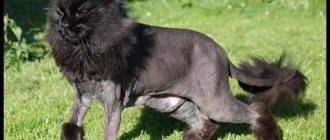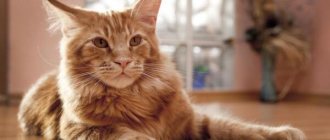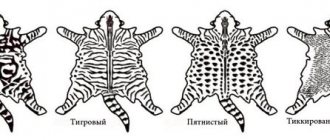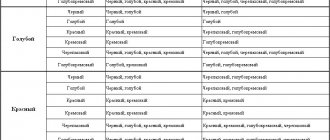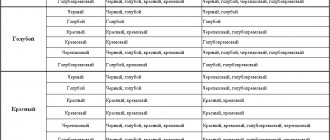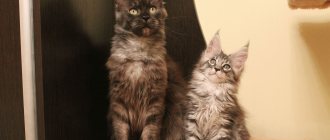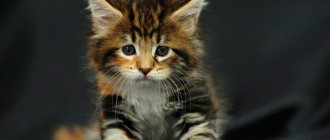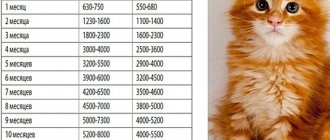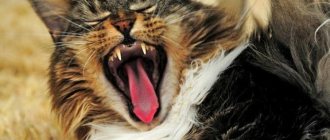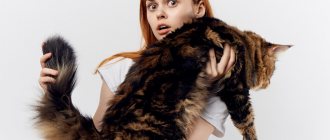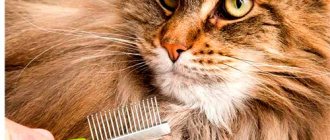Maine Coons have a luxurious, lush coat, which consists of two types of hair - a thick undercoat and a long, hard outer coat. Because of this structure, the appearance of the coons is very impressive. A cat that meets the standards has short hair on the head, thick and long hair on the collar area, on the belly and sides, and a fluffy tail. Thanks to the well-developed undercoat, the animal appears even larger.
Types of rulers
Coons shed for several reasons:
- Hormonal changes in the body.
- Seasonal changes.
- Health problems.
The first two are considered normal and natural for cats. The average lifespan of a hair is 25 days. By the time it matures, it moves away and falls out, but in animals with medium or long hair, the hairs usually become tangled and remain in the main coat.
With a very thick undercoat, shedding is accompanied by tangles; the situation is similar with a thin non-pedigree structure. Therefore, during this period it is important to take proper care, without neglecting special cosmetics or visiting a salon. In coons, the type of coat largely depends on the breeding lines, you should pay attention to this. In cats, the process is more intense. Each molt lasts about one month, sometimes more or less.
Seasonal
[ads-pc-1] This type of molting occurs when the animal independently regulates heat exchange.
In street pets it usually appears twice a year. Within a month, cats shed excess hair. The onset depends on temperature changes in nature. In domestic coons, the boundaries may be blurred, and more reasons appear. For example, dry and warm air in the apartment activates the process, which helps to avoid overheating. Sometimes diaper rash forms under a layer of old wool, tangles, which become a good environment for the development of various fungal diseases. But Maine Coons with the breed's coat structure are not prone to such manifestations, provided they receive sufficient care.
Some hairs die off constantly. Coons have hair that grows all year round, and they shed it regularly, but in small quantities. The hairs “come out” of the bulb. Seasonal shedding is easily recognized - the cat becomes less furry, and this is very noticeable. In addition, lumps of hair may appear in the stool, and the animal also regurgitates hair that got into the stomach after licking. This is a normal process for coons, but it needs to be monitored and, if anxiety occurs, help remove shed hair from the cat’s body.
Age
Coon kittens have a fairly thick undercoat, but the true color often appears after puberty.
At the age of 7-12 months (individually), cats exchange delicate fluff for adult “clothes”. This is how the junior molt begins. Under the influence of hormones, children's hair falls out. In their place, others grow, the cat’s spine becomes longer, the color is brighter, and the general appearance of the animal changes. During this period, hair loss can seem like a real disaster. In cats the intensity is less. This first coat change begins from the head. Complete renewal of the cover can occur only by 2 years. Much depends on the body’s abilities, genetic predisposition, and the conditions under which the coons are kept. Until this moment, the pet will not have strong hair growth.
Hormonal stress in cats also includes pregnancy, estrus, and the period of feeding offspring. It happens that an animal sheds almost to a bald state where the hair is initially thin (armpits, belly). After recovery, cats quickly return to their previous appearance.
Signs of illness
The condition of a cat's fur is one of the main indicators for determining diseases. Often the impetus for molting is:
- Stress.
- Problems with the gastrointestinal tract.
- Allergic reactions.
- Other diseases.
The first factor can be dealt with quite easily, but the calmness of cats cannot be neglected. Before an exhibition, long trips, moving to another home, or meeting a new member of the pack, it is advisable to give sedatives on a natural basis if the cat is prone to stress.
In the case of inappropriate nutrition, even bald spots can occur, which are difficult to treat. Eczema, dandruff, and dulling of the coat are possible, but Maine Coons are characterized by good health. In this case, food is selected, but with a preliminary visit to the veterinarian and testing.
Allergies can also be caused by improper feeding, chemical and mechanical irritations. Then the coon sheds in certain areas, usually near the ears, at the base of the tail, and the stomach. Timely treatment with the use of ointments, gels, special cosmetics and changes in diet helps.
Care during shedding
Many Maine Coons are not afraid of water and love to play with it. You can take advantage of this quality by teaching your kitten to wash itself from an early age. During the process of shedding hair, bathing with shampoo and then brushing will help relieve the cat's condition.
A hair dryer also helps. Warm air blows away dead hairs. Shampoos from certain series are suitable for washing cats with a two-layer coat during shedding, but even a regular product will improve the situation.
Brushing a Coon breed pet can bring pleasure to both the owner and the animal. When shedding, brushes are used several times a week. After manipulation, they go over the top of the coat with wet hands, collecting hairs so that the Maine Coons do not scatter it everywhere. Additionally, vitamins and mineral supplements are provided to the basic diet. Fatty acids, potassium, omega-3, calcium and zinc have beneficial properties.
Source
Maine Coon sheds a lot, what should I do?
One of the common complaints of Maine Coon owners is severe hair loss. But there is no need to panic: molting does not always signal a disease. The Maine Coon's coat requires special care. If you follow all the recommendations, it will be shiny and silky. When an animal sheds constantly, this is a reason to pay closer attention to its health.
Causes of increased oiliness in cats' fur
Maine Coons often have problems with increased oiliness in the hair in the tail, back and neck. This can happen for several reasons. Firstly, it is a consequence of a metabolic disorder in the animal. Secondly, an increase in the amount of secretion from the sebaceous glands.
If there are problems with oily fur, Maine Coon hair care should include special treatments to reduce the production of skin secretions. Also, along with this, a problem may be detected in the form of black dots at the base of the tail. Such a defect is considered only cosmetic. It can be eliminated using products containing salicylic alcohol.
Before using medications, you should consult a veterinary dermatologist.
The Maine Coon breed is unpretentious in maintenance and easy to care for. These beauties only need regular brushing. Maine Coons should only be bathed when necessary or when dirty. If you approach these procedures responsibly, feed the animal in a balanced manner and monitor its well-being, your pet’s coat will always look beautiful and well-groomed.
Causes
Shedding is a natural occurrence in cats, so there is no need to panic about it. The “new” coat has a positive effect on thermoregulation, and the animal feels better. There are more factors influencing this process than it seems.
Heavy shedding of a Maine Coon can be caused by the following reasons:
- non-compliance with hair care recommendations;
- poor nutrition;
- stress;
- seasonality;
- infectious or viral disease;
- allergic reaction;
- adverse environmental influences;
- hormonal changes.
Also, the cause of heavy shedding in Maine Coons may be a genetic predisposition. Therefore, it is worth asking about the condition of his parents’ fur. Owners should not worry if this is a seasonal phenomenon or hormonal changes caused by pregnancy or lactation.
The Maine Coon's coat is thick and soft, so it requires special care. If you use the wrong products, in addition to shedding, itching, dandruff, and the color may become dull. Therefore, you must follow all care recommendations. In other cases, you should contact your veterinarian.
When is a haircut needed?
A domestic Maine Coon needs a haircut only if there are problems with hair, skin diseases, or a large number of uncombable tangles in the animal. You should not cut your pet's hair thinking that it is hot in the summer, or simply to improve its appearance. For a good haircut effect, it is recommended to contact a professional groomer. But some owners prefer to groom their cats themselves at home.
Preparing for the Maine Coon grooming process
To prepare a Maine Coon for grooming at home, you need to follow a certain algorithm of actions:
- Bathe using a special shampoo to deeply cleanse the coat. Cats, for the most part, do not like water at all, so when bathing it is worth providing your pet with the most comfortable and calm conditions possible. You need to make sure that shampoo and water do not get on the animal’s face, especially in the eyes and ears.
- After shampoo, you can use conditioner to make it easier to comb the coat.
- It is necessary to thoroughly dry the animal's fur and, after drying, comb out all tangles.
Only after completing all these steps will you be able to start cutting.
Grooming a Maine Coon at home
In order to cut your Maine Coon's hair yourself, you need to have at home several combs with different tooth frequencies, scissors and an animal clipper. The most popular home haircut for cats is the lion haircut. In the area of the animal's head and neck, the hair is left untouched to form a mane. The rest of the fur is shaved as short as possible. Only the tassel on the tail and the hair below the elbow and knee joints on the paws are left.
After grooming, be sure to remove short cut hairs from your pet’s coat using a comb or a damp towel.
View this post on Instagram
